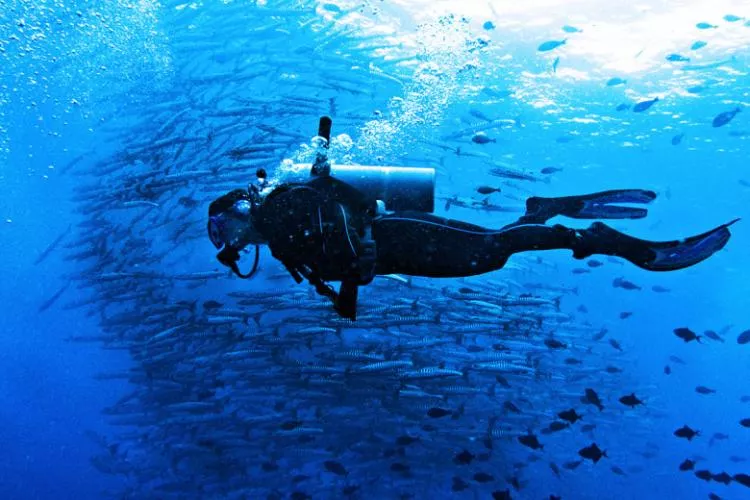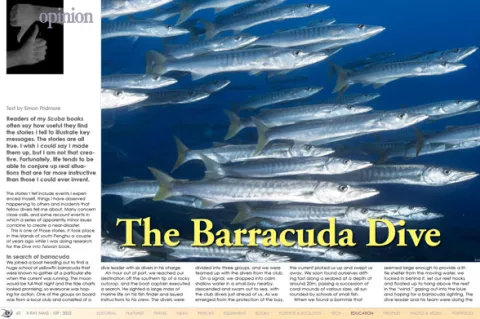Readers of my Scuba books often say how useful they find the stories I tell to illustrate key messages. The stories are all true. I wish I could say I made them up, but I am not that creative. Fortunately, life tends to be able to conjure up real situations that are far more instructive than those I could ever invent.
Contributed by
The stories I tell include events I experienced myself, things I have observed happening to others and incidents that fellow divers tell me about. Many concern close calls, and some recount events in which a series of apparently minor issues combine to create a near-disaster.
This is one of those stories. It took place in the islands of south Penghu a couple of years ago while I was doing research for the Dive into Taiwan book.
In search of barracuda
We joined a boat heading out to find a huge school of yellowfin barracuda that were known to gather at a particular site when the current was running. The moon would be full that night and the tide charts looked promising, so everyone was hoping for action. One of the groups on board was from a local club and consisted of a dive leader with six divers in his charge.
An hour out of port, we reached our destination off the southern tip of a rocky outcrop, and the boat captain executed a search. He sighted a large mass of marine life on his fish finder and issued instructions to his crew. The divers were divided into three groups, and we were teamed up with the divers from the club.
On a signal, we dropped into calm shallow water in a small bay nearby, descended and swam out to sea, with the club divers just ahead of us. As we emerged from the protection of the bay, the current picked us up and swept us away. We soon found ourselves drifting fast along a seabed at a depth of around 20m, passing a succession of coral mounds of various sizes, all surrounded by schools of small fish.
When we found a bommie that seemed large enough to provide a little shelter from the moving water, we tucked in behind it, set our reef hooks and floated up to hang above the reef in the “wind,” gazing out into the blue and hoping for a barracuda sighting. The dive leader and his team were doing the same thing above a larger bommie a few metres away.
After 20 minutes or so, a rotating school of a couple of hundred barracuda appeared in the distance. The mass of long, silver, yellow-tailed, chevroned, sharp-toothed predators approached and started circling around us. It felt like we were in the vortex of a cyclone, the eye of a fish storm. We hit the shoot button on our cameras and got some great video as the barracuda came close enough to touch, sometimes obscuring our vision of the reef completely.
Eventually, the school moved away. We glanced over at the dive leader and his team. They unhooked from the reef and started to drift again. We followed their example. Who knows? Maybe we would come across the barracuda again?
Ascending pair
Then, we saw two members of the team start to ascend. We guessed they might be low on air, due to a combination of the excitement and the effort of staying balanced on the end of their reef hook lines in the face of the current.
The dive leader did not seem to have noticed, so we glanced at each other and moved a little closer to the ascending pair, prepared to lend help if necessary. At the same time, we noticed that the seabed was falling away and guessed that the bommies below were now at around 25 to 30m. We had no desire to go any deeper at this point in the dive. We had seen what we came to see.
Then the school of barracuda returned, swimming around us again as we drifted serenely along in midwater. However, the two divers who had broken away from their team immediately dropped to the seabed when they saw the barracuda come back, presumably so they would have a more stable platform to take pictures from. They were both breathing heavily as they struggled to redeploy their reef hooks and get into position. They were both generating an almost constant stream of bubbles.
We watched from above, finning steadily to stay in place above them. This time, the barracuda did not stay long, and we saw the two divers begin to ascend again. One kept looking at his pressure gauge. The dive leader appeared, swam over to the anxious diver and, after a brief exchange of signals, they started sharing air and began to ascend slowly together. The dive leader kept looking over at the second diver, evidently concerned but powerless to help.
Second diver
We approached the second diver and signalled to ask if he was all right. The diver replied OK, but we were dubious and decided to stay close by. Nevertheless, we were still not close enough to do anything when he suddenly started heading for the surface, apparently out of control. All we could do was hope that he would manage to arrest his ascent before he hit the surface.
This he did, by deflating his BCD. Then he reached for his delayed surface maker buoy (DSMB). Good, we thought, he will now do a safety stop, then go up.
Unfortunately, the diver seemed to be having difficulty attaching a small reel to his DSMB and was concentrating so much on sorting it out that he did not notice that he was descending again, and fast. He must have just emptied his BCD completely. We were at about 13m when he came plummeting past us, heading quickly back towards the seabed. Finally, he got his reel attached, added air to his BCD to halt his fall and started inflating his DSMB. Having inflated it and let it go, he clipped the reel onto the chest D-ring on his BCD.
Buoy problem
At this point, he encountered a new problem. He must have been at a depth of around 25m when he put up his DSMB, but evidently, he had much less than 25m of line on his mini-reel. As the DSMB was about halfway through its journey to the surface, the line on the reel ran out.
The impetus of the expanding air in the DSMB was greater than the diver’s weight so up he went again, this time dragged towards the surface by the buoy spiralling through the water and connected to him by the clip on the reel. The diver had the presence of mind to push the dump on his BCD as he shot up, to slow his ascent once the DSMB hit the surface, but this time he just made the briefest of safety stops. By this point, he probably just wanted to get the dive over. Or maybe he finally ran out of air?
When we got back on the boat, the diver was there, looking a bit shell-shocked and sheepish, but otherwise he seemed fine. We noticed he did not do any more diving that day, however.
Takeaways
1. Stay focused on your air and decompression status, especially when you are diving in a current.
2. Practice controlled breathing so that it becomes instinctive. You will then be able to manage stressful situations without increasing your breathing rate and using up more air.
3. Don’t allow yourself to become distracted and get your priorities confused. The primary aim on every dive is to complete the dive safely, not see big fish or take photos.
4. Practise raising your DSMB from depth while staying neutrally buoyant until this skill also becomes instinctive.
5. Be aware of your depth as you are raising your DSMB. Turn your computer so that it is on the inside of your wrist, so you can easily see the screen while you manipulate your reel and line.
6. Know how much line you have attached to your DSMB. Measure it on land and write the length in indelible marker on the body of the reel as a reminder.
7. Never clip a reel off to your BCD. Keep it in your hand so you can release it if something goes wrong. ■
Simon Pridmore is the author of the international bestsellers Scuba Fundamental: Start Diving the Right Way, Scuba Confidential: An Insider’s Guide to Becoming a Better Diver, Scuba Exceptional: Become the Best Diver You Can Be, and Scuba Professional: Insights into Sport Diver Training & Operations, which are now available in a compendium. He is also the co-author of the Diving & Snorkeling Guide to Bali and the Diving & Snorkeling Guide to Raja Ampat & Northeast Indonesia. His recent published books include The Diver Who Fell From The Sky, Dive into Taiwan, Scuba Physiological: Think You Know All About Scuba Medicine? Think Again! and the Dining with Divers series of cookbooks. For more information, please see his website at: SimonPridmore.com.





























